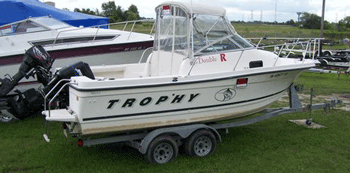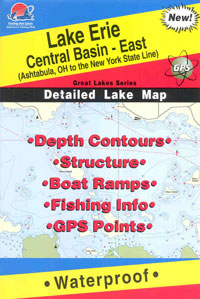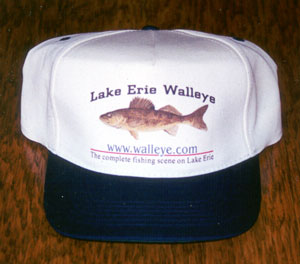|
Fall Transition Walleye Secrets
by Ted Takasaki & Scott Richardson
Though the calendar doesn’t say so yet, weather forecasters
count the time around Labor Day as the start of autumn. Walleye fishermen
can attest to the truth of that. Fish are no longer concentrated in their
summer haunts. around Labor Day as the start of autumn. Walleye fishermen
can attest to the truth of that. Fish are no longer concentrated in their
summer haunts.
Trolling structure or fishing shallow weedlines produces
fewer and fewer walleyes.
Days
are shorter. Nights are cooler. The transition has come.
“All of a sudden, walleyes aren’t where they were,” says Greg Bohn,
veteran guide, tackle designer, and member of the Lindy Fishing Tackle pro
staff. “They’re gone.”
As early as mid-August, subtle changes (that often go unnoticed) signal
the start of the fall transition period. Weeds begin dying, from colder
overnight temperatures, fewer hours of sunlight, and other factors.
“Dying weeds, that’s what starts it and pushes it,” says Bohn. “What a
lot of people don’t understand is that baitfish will only stay in those
weeds as long as they are very green. Once weeds start to die off, it seems
as though baitfish and walleyes start to leave those shallow-water weed
areas.”
Shallower, dark-water lakes enter the transition period first. Deeper,
clear-water lakes experience transition later in fall. Some lakes have green
weeds all the way to ice-up.
Walleyes on the move can be hard to locate, so the transition can be
frustrating. But, these fish migrate to predictable areas and gather in big
schools, generally according to size.
Once the big ones are located, action can be incredible.
“What the fall does is it gives the walleye angler the edge,” Bohn says.
“The fish are not spread all over the lake. They are in key spots in the
deepest part of the lake. You can literally eliminate most of the lake, as
you think about where to look.”
Where Transition Walleyes Go
“At first, they start to move out to more open-water areas,” explains
Bohn. “Sand is a really critical thing, if it’s available. They slide out to
areas around deep water, like sand bars that come out from shore and drop to
deeper water, sand flats, sand points, and sand humps.
“The real sleeper (spot, that walleye anglers don’t fish enough at this
time) is sand, especially in September. If you are fishing your summer spots
and they aren’t there, start fishing the sand.”
Don’t look for walleyes in the deeper water, though, not yet. As the
transition is getting underway, it’s still common to find walleyes in 15
feet and less.
At those depths, a good quality sonar unit can be a big help. Walleyes
may be so tight to the bottom, they’re difficult to see, but not impossible.
Humminbird has a unit that features 640 vertical pixels. Combine that with
bottom tracking and the zoom feature, and you can often pick up on walleyes
tight to the bottom. Likewise, they may be on the very top of the structure.
In that case, spooking fish can become an issue.
The bottom line is this: if an area has the characteristics that should
hold fish, fish it.
(Hint: best way to check the shallows is to keep the boat in deeper
water, cast to the top of the structure and work back down.)
Live Bait is Hot
This is the time of the year to use live bait. Early in the transition,
try half a nightcrawler on a small NO-SNAGG Timb’r Rock Jig. Drag it along
the bottom– unlike in summer, when a more aggressive ‘hop’ did the trick.
For deeper work, drift or use an electric trolling motor to slow-troll a
NO-SNAGG Rig with a 5-foot snell. In 18 feet or less, Bohn likes to use the
small 1/8- or ¼-ounce NO-SNAGG sinker. This forces him to move slowly, in
order to maintain bottom contact. Bait this rig with half a ‘crawler or a
whole minnow.
Turnover Tricks
Walleyes begin to move deeper as water temperatures drop toward turnover,
which begins at 62 degrees F or so. Instead of looking for fish to be on top
of structures, look deeper. They will be in spots like the sharper breaks or
on mid-lake humps that top out at perhaps 20 feet, rather than 15, or in
holes in soft-bottom flats where depth drops from 15 feet to 20 and then
returns to 15.
At this time, walleyes become more selective about where they stage. They
generally locate on a spot-on-a-spot. For example, if they are on a mid-lake
hump with scattered boulders, they will be on the boulders. If all rock,
look for the patch of sand. If all sand, look for the rock pile. Think about
fishing that “something different” and you’ll often be in business.
Precision with regard to location becomes important. Because more and
more walleyes show up on these few spots, more and more of the lake holds no
fish. It’s easy to be skunked if you don’t pay attention to subtle
differences on the structure. On the other hand, it can be a bonanza if you
do.
“Once you find one walleye,” Bohn says, “you’ll often find more.”
As water continues to cool down, through the 50s to the 40s, walleyes
tend to locate on structure that leads to the deepest water in the lake.
Check points or bars that extend out into the deep basin. “That’s the last
stronghold before freeze up,” Bohn says.
When water temperatures reach the 30s, walleyes that were in 15 feet of
water in mid-August are now down 45 feet or more (where this kind of depth
is available to them). They tend to seek out places where mud and hard
bottom meets in the deepest water in the lake. Deep boulders become fish
magnets.
The deeper water is warmer and holds food at that time of year.
In shallow, dark-water lakes that have a perch forage base, walleyes will
dig up mayflies and other aquatic insects from the ‘deep’ mud.
In deeper, clear lakes, they may be at 70 feet and deeper looking for
smelt, ciscoes and whitefish that are deep at that time of year. Bohn caught
a 6-pounder out of 73 feet of water last October while filming a television
show!
Bohn prefers to reach those deep fish with a ¼- or 3/8-ounce sinker. He
moves his boat slowly, so he can maintain bottom contact and pick up on
subtle bites. But, NO-SNAGG inventor, Ron Lindner, likes even heavier
sinkers. Take your pick. Dress your rig with a big redtail chub up to 5
inches long or more. That may sound huge, but 30-inch walleyes are gobbling
10-inch whitefish at this time of year.
For deep jigging or rigging, try using a St. Croix 6-foot, 6-inch casting
rod and reel spooled with 10-pound Power Pro braided line to feel the bottom
and the bites better. Keep the drag tight until the fish is hooked. Then
loosen it, and take your time reeling it to the surface to prevent damage to
the fish’s swim bladder.
Fish are on the move as fall turns to winter. Move with them and you’ll
turn cold weather fishing into a hot time on the water. |







 around Labor Day as the start of autumn. Walleye fishermen
can attest to the truth of that. Fish are no longer concentrated in their
summer haunts.
around Labor Day as the start of autumn. Walleye fishermen
can attest to the truth of that. Fish are no longer concentrated in their
summer haunts.